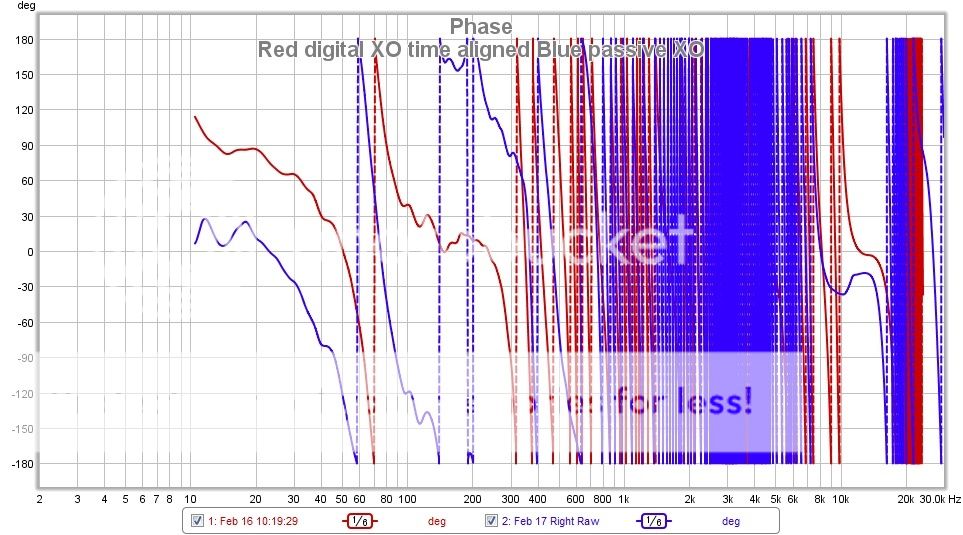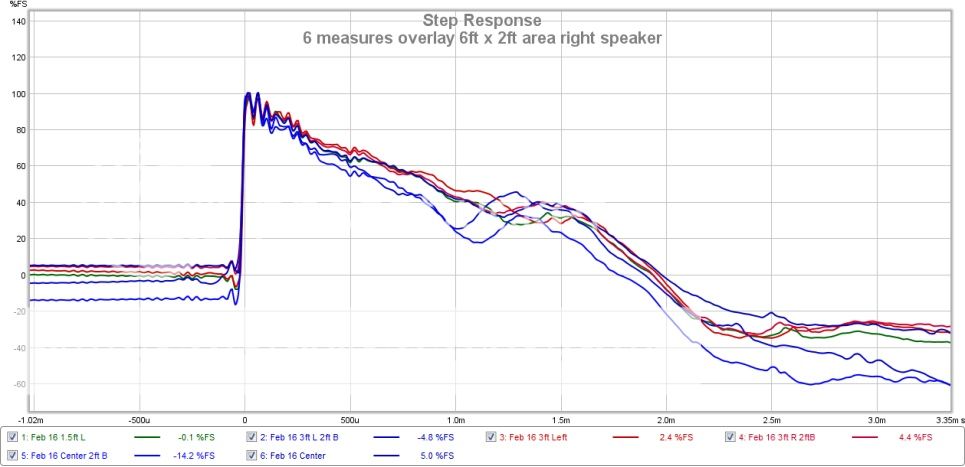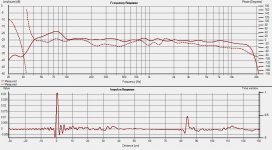In their tests of listener preference, Toole and Olive test listener preference against a measurable aspect of a speaker's performance...
Props for keeping that squarely in focus. Olive tests for preference and finds it tends towards accuracy. Not intended as a slight by any means, as far as I know he hasn't yet directly tested loudspeakers against an original source for accuracy.
Mitch, can you design a conventional crossover, i.e., with phase warp, and then compare the same crossover with phase adjusted so that all frequencies arrive at the same time? I did this test and I could not tell the difference between flat phase and normal phase (normal meaning what you get with crossovers). In JRiver, you can program the crossover and then use convolution to flatten the phase. Then ask someone else to switch the convolution in and out.
ra7, perhaps this is a point of confusion for both of us. I am not flattening the phase response in any of the scenarios described. I am time aligning the drivers as described in this article under the section Time Alignment.
Using the same measurements in which I posted the frequency and step responses in Post #50, here are the corresponding phase responses. Red is digital XO with time alignment and Blue is passive XO:

Much in the waveguides thread.Cool, can you quote a reference for "further study by the student"?
Picked this off the top of the list, I hope it's not out of context.
Gedlee said:Turns out the ear masks very well in the frequency domain, but not in the time domain. So if the nonlinear distortion is not time delayed it is highly masked by the signal. BUT, if there is a time delay in the distortion (not necessarily nonlinear) - like HOM or diffraction - then this effect is only weakly masked and quite audible. The important thing is that the masking in the time domain is SPL dependent just like the masking in the frequency domain - except that in the time domain the masking is less at higher levels (the opposite of masking in the frequency domain).
That was my point Earl, it's like searching for the holy grail.
Larry
Actually not. The Holy Grail was a myth and what we are talking about are very real and important aspects of the art. A worthwhile endeavor if you care about sound quality.
Props for keeping that squarely in focus. Olive tests for preference and finds it tends towards accuracy. Not intended as a slight by any means, as far as I know he hasn't yet directly tested loudspeakers against an original source for accuracy.
Admittedly true, but think about the difficulty of doing a live versus recorded double blind. What Toole and Olive have done is not perfect, I disagree with some of it and some of their conclusions, but they are still way ahead of anyone else in understanding what is important.
While I don’t have a nice polar map, I did measure the FR at various locations around the listening area.
A little background, my speakers are set up in an equilateral triangle, toed in pointing on-axis at the listening position. The measurement mic is pointing straight down the middle between the speakers at the listening position. Based on a single mic location, I used the frequency response target in post 31 to design/generate a correction filter containing the 3-way digital XO’s, time alignment, and room correction (both frequency and a bit of excess phase).
With the correction filter loaded in JRiver’s Convolution engine, and using JRiver’s ASIO line-in and digital loopback capabilities of my converter, I used REW to measure the end result at 6 different locations around a 6’ x 2’ grid at the listening area. Meaning I moved the mic from left, center, right covering six feet, then two feet back and left, center, and right again. Basically covering the couch area. These 6 measures are from my right speaker:

I should have colored coded better, but the one measure that is starting to succumb to the room is the one that is furthest away from the right speaker. Meaning the left back corner of the couch.
From a target frequency response comparison and constant directivity perspective. No matter where I sit on the couch, I am hearing the target frequency response with little variation. The step response is virtually identical across the listening area:

Comparing to the house curve that yields a perceptually flat frequency response at the listening position and the theoretical ideal pressure step response in air from post 31, I would say what I am listening to is both smooth and accurate.
Can I do better? Yes, another additional technique that results in an overall smoother and more accurate frequency response is to linearize each driver individually. I have yet to do that as I changed out the HF compression driver and waveguide a year ago and have not got around to it yet.
And certainly there is room to improve the drivers and cabinets. If folks saw the old school cabs (with edge diffraction and diffraction slot midrange horn) and HF waveguide sitting on top, would wonder how that correlates to the measures provided
A little background, my speakers are set up in an equilateral triangle, toed in pointing on-axis at the listening position. The measurement mic is pointing straight down the middle between the speakers at the listening position. Based on a single mic location, I used the frequency response target in post 31 to design/generate a correction filter containing the 3-way digital XO’s, time alignment, and room correction (both frequency and a bit of excess phase).
With the correction filter loaded in JRiver’s Convolution engine, and using JRiver’s ASIO line-in and digital loopback capabilities of my converter, I used REW to measure the end result at 6 different locations around a 6’ x 2’ grid at the listening area. Meaning I moved the mic from left, center, right covering six feet, then two feet back and left, center, and right again. Basically covering the couch area. These 6 measures are from my right speaker:

I should have colored coded better, but the one measure that is starting to succumb to the room is the one that is furthest away from the right speaker. Meaning the left back corner of the couch.
From a target frequency response comparison and constant directivity perspective. No matter where I sit on the couch, I am hearing the target frequency response with little variation. The step response is virtually identical across the listening area:

Comparing to the house curve that yields a perceptually flat frequency response at the listening position and the theoretical ideal pressure step response in air from post 31, I would say what I am listening to is both smooth and accurate.
Can I do better? Yes, another additional technique that results in an overall smoother and more accurate frequency response is to linearize each driver individually. I have yet to do that as I changed out the HF compression driver and waveguide a year ago and have not got around to it yet.
And certainly there is room to improve the drivers and cabinets. If folks saw the old school cabs (with edge diffraction and diffraction slot midrange horn) and HF waveguide sitting on top, would wonder how that correlates to the measures provided
Cool, can you quote a reference for "further study by the student"?
Lidia and I did an AES paper on this many years back. It is still a preprint that you can get and I think some info is on my website.
ra7, perhaps this is a point of confusion for both of us. I am not flattening the phase response in any of the scenarios described. I am time aligning the drivers as described in this article under the section Time Alignment.
Using the same measurements in which I posted the frequency and step responses in Post #50, here are the corresponding phase responses. Red is digital XO with time alignment and Blue is passive XO:

Thanks Mitch! That does help me. So, it looks like there is considerable phase lag even in the time aligned version, which means not all frequencies are arriving at the same time. I'm not sure what to make of the step response you have posted. It looks good, but I need to go back and study what it really means. If all the frequencies were really arriving at the same time, your phase would be flat. Phase is just that: the relative time of arrival of one frequency compared to others. It would measure something like the attached.
Attachments
Last edited:
Thanks Mitch! That does help me. So, it looks like there is considerable phase lag even in the time aligned version, which means not all frequencies are arriving at the same time. I'm not sure what to make of the step response you have posted. It looks good, but I need to go back and study what it really means. If all the frequencies were really arriving at the same time, your phase would be flat. Phase is just that: the relative time of arrival of one frequency compared to others.
I assume the phase plot shown is from a ~500 msec window. I think that it would look quite different gated to leave out the room.
Acourate only affects the early wave front at higher frequencies (length variable adjustable) as mentioned by Mitch. I think a phase plot of those first milliseconds would show the difference.
1. What is the relationship between a flat (smooth) frequency response and hi-fidelity accuracy?
It would mean that at any given frequency or frequency range a high accuracy speaker reproduces the actual sound as close to the source material. The input waveform would match the speaker's output, if you were to record it with a "perfect" microphone and view it on your screen.
2. Is flat or smooth frequency response a necessary condition of hi-fidelity accuracy (i.e. no flat frequency response equals no possibility of hi-fidelity accuracy)?
No, because you're ignoring the fact that human hearing does not have flat frequency sensitivity, and you're also ignoring room acoustics. The benefit of a flat speaker is that you can adjust it to sound really good in a variety of settings, and to your liking using an EQ.
3. Is flat or smooth frequency response a sufficient condition of hi-fidelity accuracy (i.e. whenever you have flat frequency response you also get hi-fidelity accuracy)?
Not necessarily, because of distortion as well as potential issues with cross-over design and cross-over point selection. Flat response just means that given a steady audio level, the speaker will not play certain frequencies higher or lower than the source - it doesn't say anything about the quality of the playback, which would be "accuracy" in your words.
4. If flat or smooth frequency response is not a sufficient condition of hi-fidelity accuracy, then what are the sufficient conditions of hi-fidelity accuracy (e.g. what role do other design elements such as cone shape, cone materials, magnetic properties, cabinet shape, cabinet materials, and so on, play in a speaker's hi-fidelity accuracy)?
Once I started using high efficiency pro audio drivers I haven't looked back. I'd look for drivers with sensitivity ratings >90 dB / 1w /1m. There are a lot out there, and sometimes the spec sheets differ from measurements. You don't need to go nuts worrying about minutia...to get good sound you'll want to consider your personal tastes and the room where you will be using the speakers. Lastly, the amp (and optionally EQ) that you will be using to power the speakers. These will all have a far greater effect on the sound you hear than anything else.
5. If flat or smooth frequency response is not a sufficient condition of hi-fidelity accuracy, then is it more or less important than things like cabinet design, cone shape, and so on?
Choose the drivers first, then design an enclosure that works for them. I like ported enclosures and prefer a woofer that works well in a ported enclosure. If know that you will be using the speakers with a subwoofer, you can further narrow your selections...bearing in mind that if you like strong bass then you'll want some overlap between the subwoofer xover point and your speaker's port tuning frequency.
Cone shape or driver type can matter if you want a more directional speaker with narrow dispersion or the opposite. The closer you will be sitting to the speaker, the wider the dispersion you'll want.
Please, in discussing this, let's try not to bring in things like the tired old subjectivist/objectivist distinction (which I actually think is a red herring) and focus on the weight that might be assigned to all the factors that go into the production of a hi-fidelity speaker.
Well, it is subjective. People have preferences just like they enjoy different kinds of music.
Lidia and I did an AES paper on this many years back. It is still a preprint that you can get and I think some info is on my website.
If you can point me to it, that'd be great
Hi Philosophil,
Wrt to frequency response, one would think the most accurate would be ruler flat. However, as Olive found out in his, “The Subjective and Objective Evaluation of Room Correction Products”.....
Cheers, Mitch
Mitch, it's worth adding the following proposal from JBL (Harman)
http://manuals.harman.com/JBL/HOM/Owner's Manual/SDEC OM.pdf
See Curve below 1 kHz, especially boost in the low frequencies. This is recording dependent, but its probably more right than wrong for average recordings.
I spend a lot of time listening to music in my work vehicle, mostly classical from the radio. It is not flat, it's not accurate a mixture of direct and reflected sound and lots of distortion and noise. Not the ideal listening environment, does this keep me from enjoying the music? No it does not, thanks to my brains ability to weed through crap I can get to the hart and soul of music and revel in its beauty!
Larry
So that's all anyone needs?
So that's all anyone needs?
I think that's all Larry needs.
If you can point me to it, that'd be great
Dave, I'd just do what you can do (cuts out the middleman). Go to AES.com and search for my name and or Lidia Lee in the preprints. About ten years ago.
Well, it is subjective. People have preferences just like they enjoy different kinds of music.
Not really. Music is an art form and preference is everything. Music reproduction is a science and preference should not be a major factor, if a factor at all.
Wow Larry, that's great. Then why bother with anything we are talking about around here if none of it will make any difference to you? I know lots of people who could care less about "sound quality" - my son for example, but he doesn't hang around an audiophile forum. He doesn't care.
i think that you're jumping to a conclusion Earl (not something that im used to reading from a scientific mind like you) , Larry didnt state that none of anything people around here are talking about here would make any difference to him.
He merely stated that he is able to enjoy music under far less than ideal conditions.
Not really. Music is an art form and preference is everything. Music reproduction is a science and preference should not be a major factor, if a factor at all.
There is science involved in both music creation and reproduction. But why wouldn't preference be a factor? You are building a speaker to listen to music you like, the way you believe it should sound. It's definitely more art than science.
In my humble opinion art comes down to what you choose to build and what you know about it beforehand. The rest is superficial. Each style has a purpose who's effects are known.
A cabinet resonance might be helpful, but you could measure it then brace the cabinet, discover the reason (even if it's personal preference) and adjust the speaker. Improvements can be made when the underlying cause is distortions, each has a way of measuring it and fixing it.
A hobbyist might want to build an omnidirectional speaker. Knowing what one does and how and why shouldn't stop it from being an individual effort, but it will prevent mistakes.
A cabinet resonance might be helpful, but you could measure it then brace the cabinet, discover the reason (even if it's personal preference) and adjust the speaker. Improvements can be made when the underlying cause is distortions, each has a way of measuring it and fixing it.
A hobbyist might want to build an omnidirectional speaker. Knowing what one does and how and why shouldn't stop it from being an individual effort, but it will prevent mistakes.
- Status
- This old topic is closed. If you want to reopen this topic, contact a moderator using the "Report Post" button.
- Home
- Loudspeakers
- Multi-Way
- Smooth (Flat) vs. Accurate (Hi-Fidelity)
